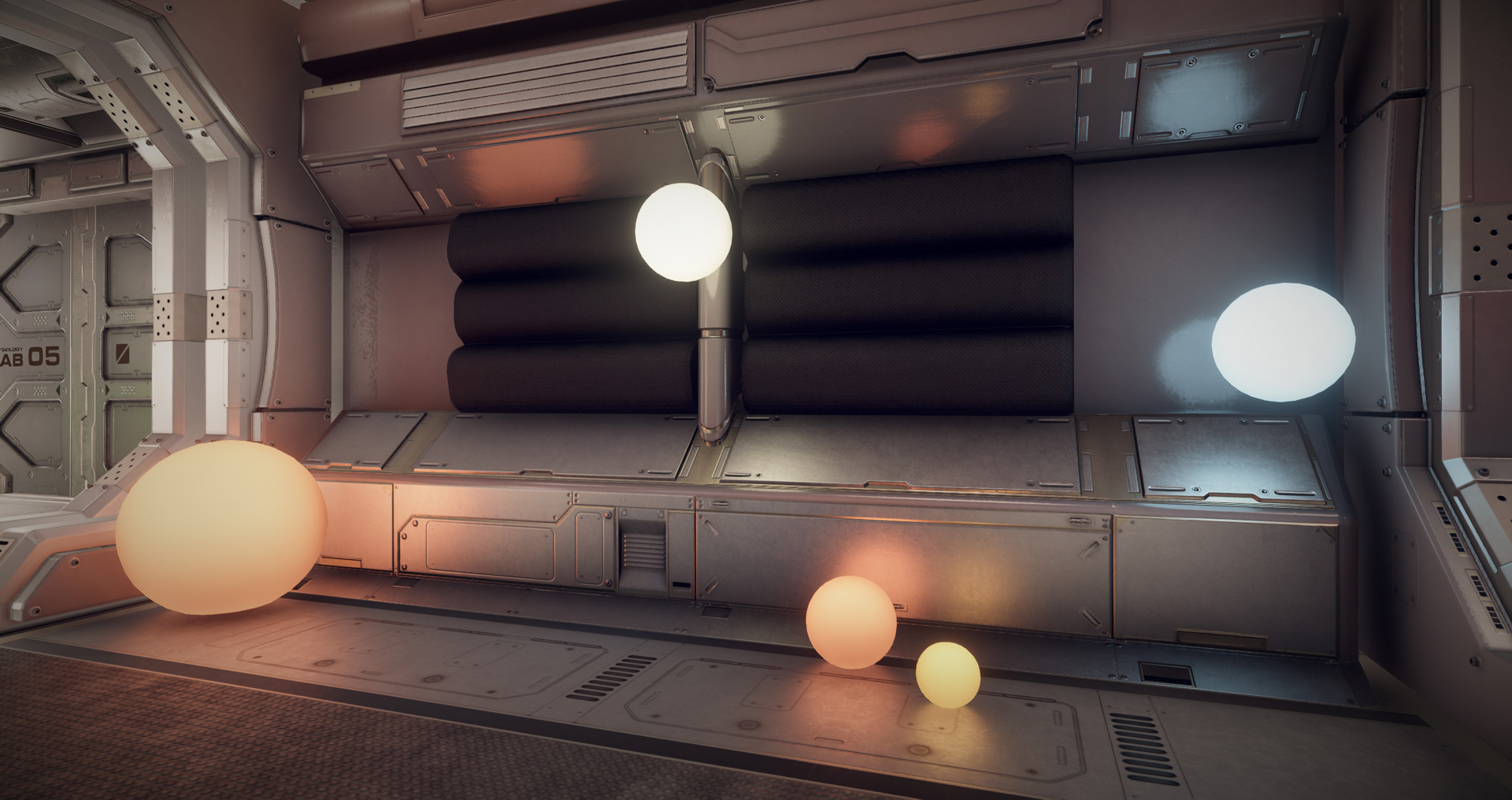“A spherical cap preserving parameterization for spherical distributions” by Dupuy, Heitz and Belcour
Conference:
Type(s):
Title:
- A spherical cap preserving parameterization for spherical distributions
Session/Category Title: Random Sampling
Presenter(s)/Author(s):
Moderator(s):
Abstract:
We introduce a novel parameterization for spherical distributions that is based on a point located inside the sphere, which we call a pivot. The pivot serves as the center of a straight-line projection that maps solid angles onto the opposite side of the sphere. By transforming spherical distributions in this way, we derive novel parametric spherical distributions that can be evaluated and importance-sampled from the original distributions using simple, closed-form expressions. Moreover, we prove that if the original distribution can be sampled and/or integrated over a spherical cap, then so can the transformed distribution. We exploit the properties of our parameterization to derive efficient spherical lighting techniques for both real-time and offline rendering. Our techniques are robust, fast, easy to implement, and achieve quality that is superior to previous work.
References:
1. James Arvo. 1995. Applications of Irradiance Tensors to the Simulation of Non-Lambertian Phenomena. In Proc. ACM SIGGRAPH. 335–342. Google ScholarDigital Library
2. David Burke, Abhijeet Ghosh, and Wolfgang Heidrich. 2005. Bidirectional Importance Sampling for Direct Illumination. In Rendering Techniques. Eurographics Association, 147–156.Google Scholar
3. Petrik Clarberg, Wojciech Jarosz, Tomas Akenine-M?ller, and Henrik Wann Jensen. 2005. Wavelet importance sampling. ACM Transactions on Graphics 24, 3 (jul 2005), 1166–1175. Google ScholarDigital Library
4. David Cline and Parris Egbert. 2006. Two stage importance sampling for direct lighting. In Rendering techniques. Eurographics Association, 103–113.Google Scholar
5. MichalDrobot. 2014. Physically based area lights. In GPU Pro 5. 67–100.Google Scholar
6. Ramy El Garawany. 2016. Deferred Lighting in Uncharted 4. In SIGGRAPH 2016 Courses: Advances in Real-Time Rendering in Games.Google Scholar
7. Ronald Fisher. 1953. Dispersion on a Sphere. Proceedings of the Royal Society of London A: Mathematical, Physical and Engineering Sciences 217, 1130 (1953), 295–305. arXiv:http://rspa.royalsocietypublishing.org/content/217/1130/295.full.pdf Google ScholarCross Ref
8. Andrew J. Hanson. 2006. Visualizing Quaternions. The Morgan Kaufmann Series in Interactive 3D Technology.Google Scholar
9. Eric Heitz, Jonathan Dupuy, Stephen Hill, and David Neubelt. 2016. Real-time Polygonal-light Shading with Linearly Transformed Cosines. ACM Trans. Graph. 35, 4, Article 41 (July 2016), 8 pages. Google ScholarDigital Library
10. Louis G Henyey and Jesse Leonard Greenstein. 1941. Diffuse radiation in the galaxy. The Astrophysical Journal 93 (1941), 70–83. Google ScholarCross Ref
11. Udo Hertrich-Jeromin. 2003. Introduction to M?bius differential geometry. Vol. 300. Cambridge University Press. Google ScholarCross Ref
12. Kei Iwasaki, Wataru Furuya, Yoshinori Dobashi, and Tomoyuki Nishita. 2012. Real-time Rendering of Dynamic Scenes under All-frequency Lighting using Integral Spherical Gaussian. In Computer Graphics Forum, Vol. 31. 727–734. Google ScholarDigital Library
13. Jorge Jim?nez. 2016. Practical Real-Time Strategies for Accurate Indirect Occlusion. In SIGGRAPH 2016 Courses: Physically Based Shading in Theory and Practice.Google Scholar
14. James T. Kajiya. 1986. The rendering equation. In Proc. SIGGRAPH ’86. ACM, 143–150. Google ScholarDigital Library
15. Brian Karis. 2013. Real Shading in Unreal Engine 4. In SIGGRAPH 2013 Courses: Physically Based Shading in Theory and Practice.Google Scholar
16. Jan Kautz, Peter-Pike Sloan, and John Snyder. 2002. Fast, Arbitrary BRDF Shading for Low-frequency Lighting Using Spherical Harmonics. In Proceedings of the 13th Eurographics Workshop on Rendering (EGRW ’02). Eurographics Association, Aire-la-Ville, Switzerland, Switzerland, 291–296.Google ScholarDigital Library
17. Oliver Klehm, Tobias Ritschel, Elmar Eisemann, and Hans-Peter Seidel. 2011. Bent Normals and Cones in Screen-space.. In Vision Modeling Visualization. Eurographics, 177–182.Google Scholar
18. Sebastien Lagarde and Charles De Rousiers. 2014. Moving Frostbite to PBR. In SIGGRAPH 2014 Courses: Physically Based Shading in Theory and Practice.Google Scholar
19. Hayden Landis. 2002. Production-ready global illumination. Siggraph Course 16, 2002 (2002), 11.Google Scholar
20. Pascal Lecocq, Arthur Dufay, Ga?l Sourimant, and Jean-Eudes Marvie. 2016. Accurate analytic approximations for real-time specular area lighting. In Proceedings of the 20th ACM SIGGRAPH Symposium on Interactive 3D Graphics and Games. 113–120. Google ScholarDigital Library
21. Stephen McAuley and Stephen Hill. 2016. Physically Based Shading in Theory and Practice. In ACM SIGGRAPH 2016 Courses (SIGGRAPH ’16). ACM, New York, NY, USA, Article 21. Google ScholarDigital Library
22. Christopher Oat and Pedro V Sander. 2007. Ambient aperture lighting. In Proc. ACM SIGGRAPH Symposium on Interactive 3D Graphics and Games. 61–64.Google ScholarDigital Library
23. Pixar. 2016. RenderMan 20 Documentation. https://renderman.pixar.com/resources/current/RenderMan/rmsPlausibleShading.html#point-and-area-lights.Google Scholar
24. Fabrice Rousselle, Petrik Clarberg, Luc Leblanc, Victor Ostromoukhov, and Pierre Poulin. 2008. Efficient product sampling using hierarchical thresholding. The Visual Computer 24, 7–9 (jun 2008), 465–474.Google ScholarDigital Library
25. Peter Shirley, Changyaw Wang, and Kurt Zimmerman. 1996. Monte carlo techniques for direct lighting calculations. ACM Transactions on Graphics (Proc. SIGGRAPH) 15, 1 (1996), 1–36.Google ScholarDigital Library
26. John M Snyder. 1996. Area light sources for real-time graphics. Technical Report. Technical report.Google Scholar
27. Andrei Tovchigrechko and Ilya A Vakser. 2001. How common is the funnel-like energy landscape in protein-protein interactions? Protein science 10, 8 (2001), 1572–1583. Google ScholarCross Ref
28. Eric Veach. 1998. Robust Monte Carlo Methods for Light Transport Simulation. Ph.D. Dissertation. Stanford, CA, USA. Advisor(s) Guibas, Leonidas J. AAI9837162.Google Scholar
29. Jiaping Wang, Peiran Ren, Minmin Gong, John Snyder, and Baining Guo. 2009. All-Frequency Rendering of Dynamic, Spatially-Varying Reflectance. In ACM Transactions on Graphics (Proc. SIGGRAPH), Vol. 28. ACM, 133.Google Scholar
30. JB Wilker. 1993. The quaternion formalism for M?bius groups in four or fewer dimensions. Linear algebra and its applications 190 (1993), 99–136. Google ScholarCross Ref
31. Kun Xu, Wei-Lun Sun, Zhao Dong, Dan-Yong Zhao, Run-Dong Wu, and Shi-Min Hu. 2013. Anisotropic Spherical Gaussians. ACM Trans. Graph. 32, 6, Article 209 (Nov. 2013), 11 pages. Google ScholarDigital Library
32. Isaak Moiseevich Yaglom. 2014. Complex Numbers in Geometry. Academic Press.Google Scholar





